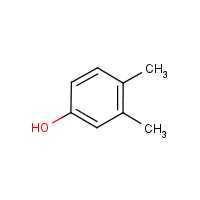3,4-Dimethylphenol
Agent Name
3,4-Dimethylphenol
Alternative Name
3,4-Xylenol
CAS Number
95-65-8
Formula
C8-H10-O
Major Category
Other Classes

Synonyms
1,3,4-Xylenol; 1-Hydroxy-3,4-dimethylbenzene; 3,4-DMP; 4,5-Dimethylphenol; 4-Hydroxy-1,2-dimethylbenzene; Phenol, 3,4-dimethyl-; [ChemIDplus] UN2261
Category
Phenols
Description
Colorless to tan solid; Hygroscopic; [CAMEO] White or yellow crystalline solid; [MSDSonline]
Sources/Uses
Used as a starting material for phenolic resins; [HSDB]
Comments
Safe when used as a flavoring agent in food; [JECFA] Causes tetany, hepatitis, and renal tubular changes in lethal-dose feeding studies of rats; [RTECS] Toxic by ingestion; [HSDB] Corrosive to tissues; May cause spasm, inflammation, and edema of the larynx and bronchi after inhalation; Can cause liver and kidney damage; [CAMEO] May cause burns; [eChemPortal: ESIS] A corrosive substance that can cause injury to the skin, eyes, and respiratory tract; Inhalation may cause chemical pneumonitis; May be absorbed through skin; Effects in high-dose animal studies include acute tubular necrosis and hepatitis; [MSDSonline] "As the six dimethylphenol isomers and the mixed isomer substance are generally similar in toxicity, a common TLV for these substances is appropriate. . . . In mice, oral exposure to 250 mg/kg/day produced changes in blood parameters including statistically significant decreases in mean corpuscular volume and mean corpuscular hemoglobin concentration (4 and 3% reduction in mean values, respectively. . . . Available data on skin sensitization from exposure to dimethylphenol are mixed but warrant the addition of a DSEN notation. . . . All six dimethylphenol isomers were tested in a mouse local lymph node assay and the results found 2.4, 2,5, and 3,4-dimethylphenol to be positive for skin sensitization." There are no epidemiology studies. In a case report, ingestion of about 250 ml of a mixture of dimethylphenol isomers resulted in CNS depression, hypotension, and death. [ACGIH] See "Phenol."
Biomedical References
Exposure Assessment
TLV (ACGIH)
1 ppm, inhalable fraction and vapor
Vapor Pressure
0.0356 mm Hg
Explanatory Notes
Odor threshold = 0.003 mg/m3 (detection in air); [HSDB] The Guide in the Emergency Response Guidebook is for "Xylenols, solid."
Adverse Effects
Skin Sensitizer
Yes
Toxic Pneumonitis
Yes
Neurotoxin
Other CNS neurotoxin
Hepatotoxin
Hepatoxic (a) from occupational exposure (secondary effect) or (b) in animal studies or in humans after ingestion
Dermatotoxin
Skin burns
ACGIH Carcinogen
Confirmed Animal
Diseases, Processes, and Activities Linked to This Agent
Diseases
Occupational diseases associated with exposure to this agent: